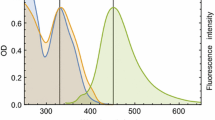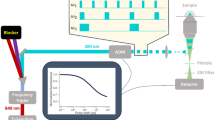Abstract
The rate of intermolecular energy transfer (ET) between tyrosine and triptophan residues in human serum albumin (HSA) was estimated based on the information about its structure from X-ray crystallographic data provided in protein databank (PDB) as well as from fluorescent measurements. The possibility of indicating of protein molecule’s conformational changes via intrinsic ET was shown by the analysis of PDB-structures of HSA and its complexes with different ligands. The manifestation of conformational changes of HSA in its fluorescence properties connected with the tyrosine-tryptophan ET was studied by means of steady-state spectroscopy and picosecond time-resolved technique.
Access provided by Autonomous University of Puebla. Download conference paper PDF
Similar content being viewed by others
Keywords
- Conformational changes
- Human serum albumin (HSA)
- Intrinsic energy transfer
- Picosecond time-resolved fluorescence
- Steady-state fluorescence
The rate of intermolecular energy transfer (ET) between tyrosine and triptophan residues in human serum albumin (HSA) was estimated based on the information about its structure from X-ray crystallographic data provided in protein databank (PDB) as well as from fluorescent measurements. The possibility of indicating of protein molecule’s conformational changes via intrinsic ET was shown by the analysis of PDB-structures of HSA and its complexes with different ligands. The manifestation of conformational changes of HSA in its fluorescence properties connected with the tyrosine-tryptophan ET was studied by means of steady-state spectroscopy and picosecond time-resolved technique.
Human serum albumin (HSA) is the most abundant protein of human blood plasma responsible for the transportation of different substances (e.g. fatty acids, drugs, metabolites). Binding of drugs to HSA and the dependency of the efficiency of this process on microenvironment is being extensively studied in literature. It is well-accepted that protein conformation, its structure and position of binding sites, is the basic property determining binding efficiency (Varshney et al., Chirality 22:77–87, 2010).
To investigate conformational changes in proteins different techniques can be applied. While the analysis of X-ray structure of HSA and its complexes with different ligands provide the information about conformational changes on a subnanometer scale, optical spectroscopy doesn’t possess atomic resolution, but it is much more accessible and allows one to study structural changes in real time.
Among different optical techniques the method based on fluorescence (Forster) resonance energy transfer (FRET) (Lakowicz, Principles of fluorescence spectroscopy. Springer, New York, 2007) should be noted as for it allows one to measure changes in relative position of pair of fluorophores. The investigation of conformational changes in protein in different environmental conditions via FRET techniques is one of the hot topics in modern biophysics.
A number of works make use of protein labeling with fluorophores that bind specifically to particular sites and can serve as energy acceptor (or donor, or both). It should be noted that binding of an external label can induce changes in protein structure as well as the investigated direct influence by chemical agents (Anand et al., J Phys Chem B 114:15839–15845, 2010) (e.g. surfactants, guanidine hydrochloride, urea) or alterations in temperature, pH, etc. At the same time it’s well-known that many proteins contain the internal FRET pair: tyrosine (Tyr) and tryptophan (Trp) residues that represent a donor-acceptor FRET pair (Saito et al., Photochem Photobiol 33:289–295, 1981; Chiu and Bersohn, Biopolymers 16:277–288, 1977; Eisenhawer et al., Biochemistry 40:12321–12328, 2001). Despite that Tyr-Trp energy transfer is a well-known phenomenon in protein photophysics, it has not been thoroughly investigated due to experimental limitations. The recent advances in optical instrumental techniques and the accessibility of protein databank (PDB) allow one to reinvestigate the intramolecular FRET as a tool to detect the conformational changes in macromolecules.
In this paper the complex approach based on the analysis of PDB-structures and application of fluorescent techniques (steady-state and picosecond time-resolved methods) is developed for investigation the conformational changes in HSA and its complexes with different ligands. It was shown that Tyr-Trp energy transfer can be used as an effective indicator of structural changes in proteins.
Author information
Authors and Affiliations
Corresponding author
Editor information
Editors and Affiliations
Rights and permissions
Copyright information
© 2015 Springer Science+Business Media Dordrecht
About this paper
Cite this paper
Zhdanova, N.G., Shirshin, E.A., Panchishin, I.M., Fadeev, V.V., Maskevich, A.A. (2015). On the Possibility of Indicating Protein Conformational Changes via Energy Transfer Between Intrinsic Fluorophores. In: Di Bartolo, B., Collins, J., Silvestri, L. (eds) Nano-Structures for Optics and Photonics. NATO Science for Peace and Security Series B: Physics and Biophysics. Springer, Dordrecht. https://doi.org/10.1007/978-94-017-9133-5_34
Download citation
DOI: https://doi.org/10.1007/978-94-017-9133-5_34
Published:
Publisher Name: Springer, Dordrecht
Print ISBN: 978-94-017-9132-8
Online ISBN: 978-94-017-9133-5
eBook Packages: Physics and AstronomyPhysics and Astronomy (R0)




